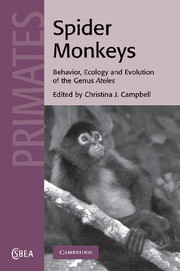Book contents
- Frontmatter
- Contents
- List of contributors
- Acknowledgements
- 1 Introduction
- Part I Taxonomy, phylogeny and evolution
- Part II Ecology
- Part III Behavior and reproduction
- 7 Locomotion and positional behavior of spider monkeys
- 8 Communication in spider monkeys: the function and mechanisms underlying the use of the whinny
- 9 Social interactions, social relationships and the social system of spider monkeys
- 10 Spider monkey reproduction and sexual behavior
- 11 Immaturity in spider monkeys: a risky business
- 12 Demography and group composition of Ateles
- Part IV Interactions with humans
- Index
- References
9 - Social interactions, social relationships and the social system of spider monkeys
Published online by Cambridge University Press: 05 May 2010
- Frontmatter
- Contents
- List of contributors
- Acknowledgements
- 1 Introduction
- Part I Taxonomy, phylogeny and evolution
- Part II Ecology
- Part III Behavior and reproduction
- 7 Locomotion and positional behavior of spider monkeys
- 8 Communication in spider monkeys: the function and mechanisms underlying the use of the whinny
- 9 Social interactions, social relationships and the social system of spider monkeys
- 10 Spider monkey reproduction and sexual behavior
- 11 Immaturity in spider monkeys: a risky business
- 12 Demography and group composition of Ateles
- Part IV Interactions with humans
- Index
- References
Summary
Introduction
Primates live in a variety of social systems that differ in terms of spacing, grouping and mating patterns as well as the quality of social relationships between individual members (Crook and Gartland, 1966; Clutton-Brock, 1974; van Schaik and van Hooff, 1983; Wrangham, 1987; Dunbar, 1988; Strier, 1994; Janson, 2000; Isbell and Young, 2002; Fuentes, 2007). Three important components of a social system are social organization, social structure and mating system (Kappeler and van Schaik, 2002). In this chapter we focus on the social structure of spider monkeys and its components; social interactions and social relationships. First we start with fission–fusion dynamics, an aspect of social organization that is critical for the understanding of the spider monkeys' social system.
Fission–fusion dynamics
According to Kappeler and van Schaik (2002), social organization describes the size, sexual composition and spatiotemporal cohesion of a social system. The aspect of spatiotemporal cohesion is typically not emphasized in group-living primates because groups are usually viewed as cohesive units. Although variation in spatiotemporal cohesion also occurs in “cohesive” groups, it has mainly been used to characterize species living in so-called “fission–fusion societies.”
The term “fission–fusion” was introduced by Hans Kummer (1971) to describe a social system in which group size can be temporarily adjusted to the availability and distribution of resources by means of the fission and fusion of subunits called parties or subgroups.
- Type
- Chapter
- Information
- Spider MonkeysThe Biology, Behavior and Ecology of the Genus Ateles, pp. 236 - 265Publisher: Cambridge University PressPrint publication year: 2008
References
- 59
- Cited by

